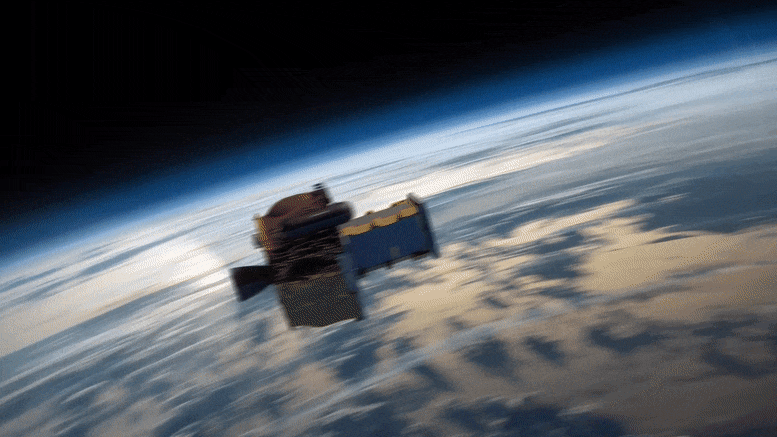Mission Team Determines Cause of Communications Issue
The Cislunar Autonomous Positioning System Technology Operations and Navigation Experiment, or CAPSTONE, is a CubeSat that will fly a unique orbit around the Moon intended for NASA’s future Artemis lunar outpost Gateway. Its six-month mission will help launch a new era of deep space exploration. Credit: NASA Ames Research Center
Mission Team Determines Cause of NASA’s CAPSTONE Communications Issues
After its launch on June 28, CAPSTONE orbited Earth attached to Rocket Lab’s Photon upper stage, which maneuvered it into position for its voyage to the Moon. Following successful deployment and start of spacecraft commissioning on July 4, the CAPSTONE spacecraft experienced communications issues while in contact with the Deep Space Network (DSN). The mission team, led by Advanced Space, re-established contact with CAPSTONE at 9:26 a.m. EDT (6:26 a.m. PDT) on July 6.
Now, after a thorough review, teams have established what led to CAPSTONE’s communications problems that began on July 4.
During the commissioning of NASA’s CAPSTONE spacecraft, the Deep Space Network team noted inconsistent ranging data. While investigating this issue, the spacecraft operations team attempted to retrieve diagnostic data on the spacecraft’s radio and sent an incorrectly formatted command that made the radio inoperable. The spacecraft fault detection system should have rebooted the radio immediately but did not because of a fault in the spacecraft flight software.
Eventually, CAPSTONE’s autonomous flight software system cleared the fault and brought the spacecraft back into communication with the ground, allowing the team to implement recovery procedures and begin commanding the spacecraft again.
While CAPSTONE was out of contact with Earth, the spacecraft autonomously maintained proper orientation to keep its antenna pointed towards Earth and allow the solar panels to keep the battery charged. CAPSTONE also used its thrusters to perform a standard maneuver to dump excess momentum from its reaction wheels, which are internal wheels that help the spacecraft rotate and point itself.
The mission operations team conducted CAPSTONE’s first trajectory correction maneuver at approximately 11:30 a.m. EDT (8:30 a.m. PDT) on July 7. Teams are currently reviewing the data to ensure the maneuver was successful. This maneuver is intended to more precisely target the spacecraft’s transfer orbit to the Moon.

The Cislunar Autonomous Positioning System Technology Operations and Navigation Experiment, or CAPSTONE, is a CubeSat that will fly a unique orbit around the Moon intended for NASA’s future Artemis lunar outpost Gateway. Its six-month mission will help launch a new era of deep space exploration. Credit: NASA Ames Research Center
Mission Team Determines Cause of NASA’s CAPSTONE Communications Issues
After its launch on June 28, CAPSTONE orbited Earth attached to Rocket Lab’s Photon upper stage, which maneuvered it into position for its voyage to the Moon. Following successful deployment and start of spacecraft commissioning on July 4, the CAPSTONE spacecraft experienced communications issues while in contact with the Deep Space Network (DSN). The mission team, led by Advanced Space, re-established contact with CAPSTONE at 9:26 a.m. EDT (6:26 a.m. PDT) on July 6.
Now, after a thorough review, teams have established what led to CAPSTONE’s communications problems that began on July 4.
During the commissioning of NASA’s CAPSTONE spacecraft, the Deep Space Network team noted inconsistent ranging data. While investigating this issue, the spacecraft operations team attempted to retrieve diagnostic data on the spacecraft’s radio and sent an incorrectly formatted command that made the radio inoperable. The spacecraft fault detection system should have rebooted the radio immediately but did not because of a fault in the spacecraft flight software.
Eventually, CAPSTONE’s autonomous flight software system cleared the fault and brought the spacecraft back into communication with the ground, allowing the team to implement recovery procedures and begin commanding the spacecraft again.
While CAPSTONE was out of contact with Earth, the spacecraft autonomously maintained proper orientation to keep its antenna pointed towards Earth and allow the solar panels to keep the battery charged. CAPSTONE also used its thrusters to perform a standard maneuver to dump excess momentum from its reaction wheels, which are internal wheels that help the spacecraft rotate and point itself.
The mission operations team conducted CAPSTONE’s first trajectory correction maneuver at approximately 11:30 a.m. EDT (8:30 a.m. PDT) on July 7. Teams are currently reviewing the data to ensure the maneuver was successful. This maneuver is intended to more precisely target the spacecraft’s transfer orbit to the Moon.
